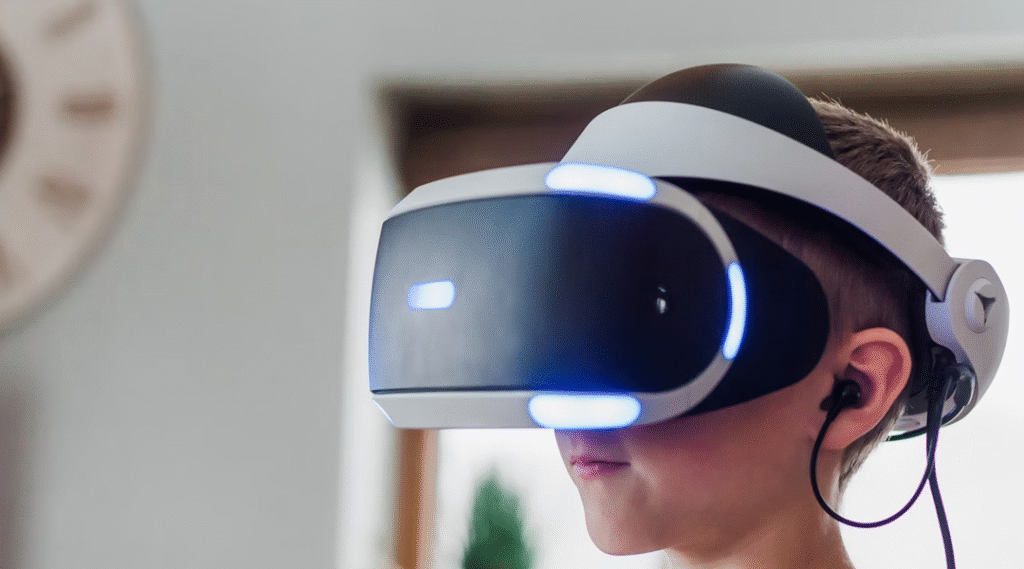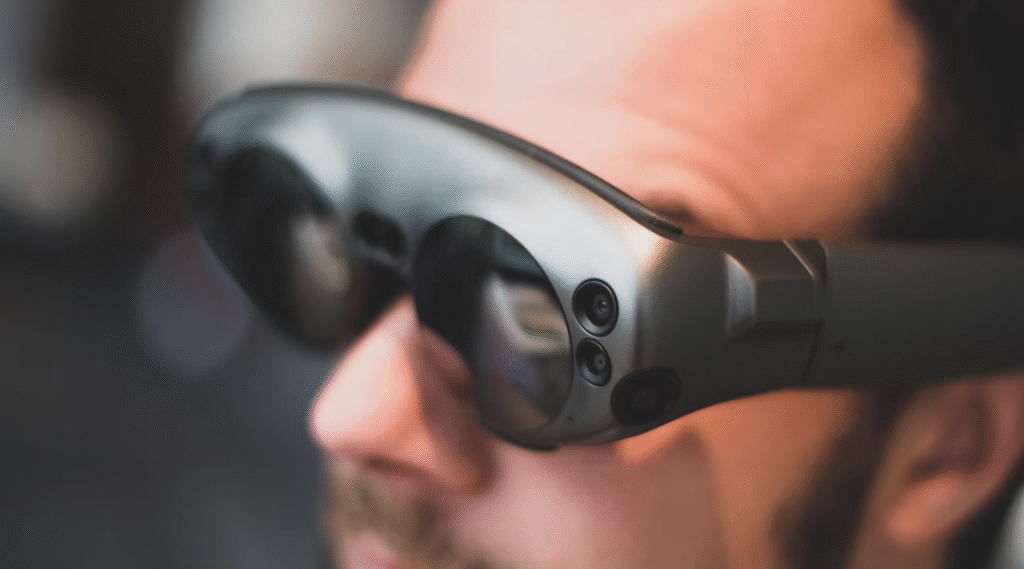The global race to define the next computing platform is intensifying, and glasses are at the center of this competition. Augmented Reality (AR), Artificial Intelligence (AI)-powered, and Virtual Reality (VR) glasses are no longer niche prototypes—they represent converging pathways toward immersive, intelligent, and hands-free experiences. Each technology has unique strengths, adoption hurdles, and leading players vying for dominance. Understanding their differences and market trajectories reveals where the most value might emerge.
AR Glasses: Augmenting Reality in Real Time
Definition & Value
AR glasses overlay digital content onto the physical world, blending contextual information with real-time experiences. Unlike VR, they aim to be worn in daily life, serving as “assistive layers” rather than replacements for reality.
Use Cases
- Real-time navigation and directions
- Maintenance and industrial work assistance
- Education and training modules
- Entertainment through lightweight overlays
Major Players
- Microsoft (HoloLens): Dominates the enterprise AR space with mixed-reality headsets focused on industrial and defense use cases.
- Snap (Spectacles): Experimenting with consumer AR, though adoption remains limited.
- Magic Leap: Pivoted from consumer hype to enterprise solutions.
- Apple (Vision Pro as a stepping stone): Though Vision Pro is technically mixed reality, Apple is expected to pivot toward lighter AR glasses in the long term.
Challenges
AR faces major hardware hurdles: battery life, miniaturization of optics, and social acceptability. A pair of stylish, lightweight AR glasses that consumers can wear daily remains a technological dream.
AI Glasses: The New Entrant With Everyday Potential
Definition & Value
AI glasses represent a new category powered by voice, vision, and contextual intelligence. Unlike AR, they don’t need to project rich 3D visuals into the environment. Instead, they use AI to interpret the world, answer questions, and assist hands-free—bridging the gap between a smartphone and an assistant living in your eyewear.
Use Cases
- Real-time translation and transcription
- Visual search (“What am I looking at?”)
- Personal assistant tasks (scheduling, reminders, calls)
- Social integration (capturing, posting, live sharing)
Major Players
- Meta x Ray-Ban Smart Glasses: Already in the market with voice-enabled assistants, camera features, and a roadmap to deeper AI integration.
- Brilliant Labs: A startup focusing on AI-first glasses with built-in displays and multimodal AI.
- Potential entrants (Amazon, Samsung): With strong AI ecosystems, they could expand into AI glasses quickly.
Advantages
AI glasses may leapfrog AR because they demand less from optics and can rely heavily on audio, lightweight HUDs, or contextual prompts. They also benefit from rapid advances in generative AI and multimodal models.
Challenges
Accuracy, battery life, and privacy remain key obstacles. Users may hesitate to wear devices that continuously listen, see, or record their environment.
VR Glasses: Immersing in Digital Worlds
Definition & Value
VR glasses or headsets immerse users in fully digital environments, isolating them from the physical world. They’ve already gained traction in gaming and enterprise training.
Use Cases
- Gaming and immersive entertainment
- Corporate training simulations
- Virtual collaboration and design
- Healthcare therapy and rehabilitation
Major Players
- Meta (Quest series): Market leader in consumer VR with affordable devices and strong developer support.
- Sony (PlayStation VR2): Tied closely to gaming ecosystems.
- Pico (ByteDance-owned): Competing aggressively in China and Europe.
- Apple (Vision Pro): Although marketed as “spatial computing,” Apple’s device currently emphasizes premium VR/MR experiences.
Challenges
VR adoption is still limited by headset bulk, motion sickness, and content availability. While compelling for gaming and enterprise, VR has not yet broken through into mainstream daily use.

Quick Comparison: AR vs. AI vs. VR Glasses
| Feature/Aspect | AR Glasses | AI Glasses | VR Glasses |
|---|---|---|---|
| Primary Function | Overlay digital content on real world | Provide AI-powered contextual assistance | Full immersion in digital environments |
| Immersion Level | Partial (augmented reality) | Minimal visuals, heavy on audio/AI | Full immersion, blocks physical reality |
| Key Use Cases | Navigation, enterprise, training, social | Translation, assistants, social capture | Gaming, training, virtual collaboration |
| Major Players | Microsoft, Snap, Apple, Magic Leap | Meta, Brilliant Labs, Amazon (potential) | Meta, Sony, Pico, Apple |
| Hardware Maturity | Early-stage, enterprise-first | Emerging, consumer-friendly potential | Most mature, strong in gaming |
| Adoption Path | Enterprise → Consumer (later) | Everyday consumers first | Gaming & enterprise early adopters |
| Main Challenges | Optics, battery, wearability | Privacy, accuracy, battery | Bulkiness, motion sickness, limited apps |
Capital Flows and Market Trends
Investment trends suggest the industry is bifurcating:
- Billions continue to flow into VR gaming ecosystems (Meta, Sony, Pico).
- Enterprise AR attracts targeted capital from industrial and defense applications.
- AI glasses are drawing new venture interest as generative AI matures. Meta’s recent collaborations with Ray-Ban and ongoing AI R&D hint at massive consumer plays.
Venture capitalists increasingly see AI glasses as lower-risk than AR, since the path to consumer adoption is clearer and hardware requirements are less extreme.
Short-Term vs. Long-Term Winners
- Short-Term (1–3 years):
- VR glasses will continue leading in gaming and enterprise training, supported by Meta, Sony, and Pico.
- AI glasses are likely to gain traction among early adopters because of practical, lightweight use cases such as translation, calls, and voice assistants.
- AR glasses will remain mostly enterprise-focused due to technical hurdles.
- Medium to Long-Term (5–10 years):
- AI glasses could scale fastest with consumers, since they fit into daily routines without demanding full immersion or heavy optics.
- AR glasses may eventually dominate once optics, wearability, and battery challenges are solved—potentially unlocking a true “everyday computing” device.
- VR glasses will likely remain strong in gaming, entertainment, and specific enterprise verticals but less dominant in consumer mainstream adoption.
Overall Outlook:
- AI glasses = near-term breakout category
- AR glasses = long-term transformative potential
- VR glasses = steady but specialized role
Convergence on the Horizon
The distinctions among AR, AI, and VR glasses may blur. AI will inevitably become part of AR and VR devices, powering natural interfaces and contextual intelligence. Meanwhile, AR may inherit features from AI glasses as display technology matures. VR may remain the entertainment stronghold, while AI-first designs carve a path to everyday wearability.
In the short term, AI glasses may scale fastest with consumers, VR will dominate immersive entertainment, and AR will remain an enterprise-first story. Long term, the race is to converge these technologies into lightweight, socially acceptable glasses that redefine personal computing.
More Relative Articles You May Like:
If Meta Will Dominate the AI Glasses Market
From Screen to Lens: Can AI Glasses Truly Take Over the Role of Smartphones?
AI and IoT: Forging the Next Generation of Intelligent Connectivity
As for in-depth insight articles about AI tech, please visit our AI Tech Category here.
As for in-depth insight articles about Auto Tech, please visit our Auto Tech Category here.
As for in-depth insight articles about Smart IoT, please visit our Smart IoT Category here.
As for in-depth insight articles about Energy, please visit our Energy Category here.
If you want to save time for high-quality reading, please visit our Editors’ Pick here.



